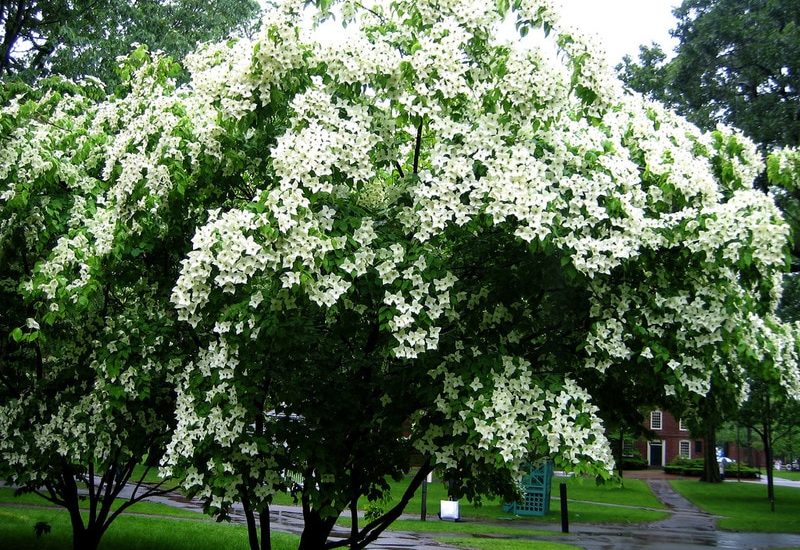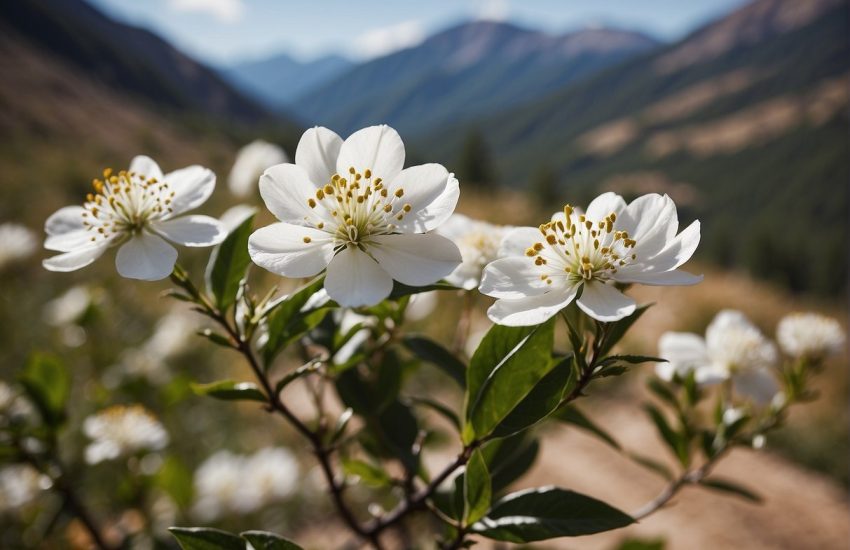Florida Tree with Red Blooms: Meet the Royal Poinciana
Florida is known for its beautiful landscapes and diverse flora, which includes a variety of trees that bloom with vibrant colors throughout the year. One such tree that stands out for its striking red blooms is the Royal Poinciana. This tree is native to Madagascar but has become a popular ornamental tree in Florida due to its stunning appearance.

The Royal Poinciana tree is a deciduous tree that typically grows up to 40 feet tall and can spread up to 60 feet wide. Its fern-like leaves are a bright green color and can grow up to 20 inches long. The tree’s most impressive feature is its large clusters of bright red flowers that bloom in late spring and early summer. These flowers can grow up to a foot long and are a sight to behold, making the tree a popular choice for landscaping.
Overall, the Royal Poinciana tree is a beautiful addition to any Florida landscape, adding a pop of color and vibrancy with its stunning red blooms. Its unique appearance and easy-to-care-for nature make it a popular choice for homeowners and landscapers alike.
Types of Red-Blooming Trees in Florida
Florida is known for its beautiful and diverse array of trees, many of which produce stunning red blooms. Here are some of the most popular types of red-blooming trees in Florida:
Royal Poinciana (Delonix Regia)
The Royal Poinciana, also known as the Flame Tree, is a stunning ornamental tree native to Madagascar. It is widely planted in Florida for its beautiful, fiery red blooms that appear in the summer months. The tree can grow up to 40 feet tall and has a wide, umbrella-shaped canopy that provides ample shade.
Red Buckeye (Aesculus Pavia)
The Red Buckeye is a small, native tree that produces clusters of bright red flowers in the spring. The tree typically grows to be about 10-20 feet tall and is often used as an ornamental tree in gardens and landscapes. The Red Buckeye is also an important source of nectar for hummingbirds and other pollinators.
Crape Myrtle (Lagerstroemia)
The Crape Myrtle is a popular ornamental tree that produces clusters of red, pink, or purple flowers in the summer months. The tree can grow up to 30 feet tall and is prized for its beautiful, peeling bark and vibrant fall foliage. The Crape Myrtle is also relatively low-maintenance and can tolerate a variety of soil types.
Bottlebrush (Callistemon)
The Bottlebrush is a unique tree with bright red, brush-like flowers that resemble a bottle brush. The tree is native to Australia but is widely planted in Florida for its striking appearance and ability to attract hummingbirds and other pollinators. The Bottlebrush can grow up to 20 feet tall and is relatively low-maintenance, making it a popular choice for gardens and landscapes.
Overall, these red-blooming trees add a striking pop of color to Florida’s already beautiful landscape. Whether you’re looking for an ornamental tree or a native species, there are plenty of options to choose from.
Growing Conditions and Care

Soil and Sunlight Requirements
Florida trees with red blooms require well-drained soil and full sun exposure for optimal growth. The ideal soil pH level for these trees is between 6.0 and 7.5. If the soil is not well-drained, it can lead to root rot and other diseases that can harm the tree. It is important to ensure that the soil is moist but not waterlogged, as overwatering can also lead to root rot.
Watering and Pruning
Regular watering is essential for the growth of Florida trees with red blooms. These trees are drought tolerant but still require watering during dry spells. It is best to water them deeply and infrequently rather than shallowly and frequently. This will encourage the roots to grow deeper into the soil, making the tree more resilient to drought.
Pruning is also an important aspect of caring for these trees. Pruning should be done in the late winter or early spring before the tree starts to produce new growth. This will help to shape the tree and remove any dead or diseased branches.
Climate and Hardiness Zones
Florida trees with red blooms are well-suited to tropical climates. They are hardy in USDA hardiness zones 9b to 11, which covers most of Florida and parts of the southern United States. These trees can tolerate high temperatures and humidity, but they may struggle in cooler climates.
In summary, caring for Florida trees with red blooms requires well-drained soil, full sun exposure, regular watering, and pruning. These trees are well-suited to tropical climates and are hardy in USDA hardiness zones 9b to 11. By following these guidelines, gardeners can enjoy the beauty of these trees for many years to come.
Environmental Impact and Landscaping

Attracting Wildlife
The Florida tree with red blooms is a great addition to any garden or landscape as it attracts a variety of wildlife such as hummingbirds, butterflies, and other pollinators. These beautiful creatures are drawn to the vibrant red flowers, which provide them with an excellent source of nectar. By planting this tree, homeowners can create a habitat that supports the local ecosystem and promotes biodiversity.
Non-Native Species and Invasiveness
It is important to note that some non-native species of the Florida tree with red blooms can be invasive. Homeowners should be cautious when selecting a tree to plant and ensure that it is not a species that may become invasive and harm the local environment. It is recommended to consult with a local expert or nursery to ensure that the tree is suitable for the area.
Tree Placement and Visual Appeal
The Florida tree with red blooms is a stunning addition to any landscape and can be used as a focal point or as part of a larger planting scheme. When selecting a location for the tree, it is important to consider its size and growth habits. This tree can grow up to 30 feet tall and 20 feet wide, so it is important to plant it in a location that can accommodate its size.
Additionally, the tree’s visual appeal can be enhanced by planting it in a location that provides a contrasting backdrop or by using other plants that complement its red blooms. Homeowners can also use various landscaping techniques such as pruning and shaping to create a unique and visually appealing tree.
In conclusion, the Florida tree with red blooms is a great addition to any landscape as it attracts wildlife, promotes biodiversity, and adds visual appeal. However, homeowners should be cautious when selecting a tree to plant and ensure that it is not a species that may become invasive and harm the local environment. By following these guidelines, homeowners can create a beautiful and sustainable landscape that supports the local ecosystem.
Common Challenges and Solutions

Pest and Disease Management
Florida tree with red blooms is susceptible to pests and diseases, which can cause significant damage if not managed effectively. Common pests that affect the tree include spider mites, whiteflies, and scale insects. These pests can cause leaf drop and weaken the tree, making it more susceptible to disease.
To manage pests, it is essential to regularly inspect the tree for signs of infestation and take appropriate action. This may include using insecticidal soap or horticultural oil to control the pests. It is also important to maintain good cultural practices, such as proper watering and fertilization, to keep the tree healthy and strong.
Diseases that commonly affect Florida tree with red blooms include root rot and fungal leaf spots. To manage these diseases, it is important to maintain good drainage and avoid overwatering. Fungicides may also be used to control fungal leaf spots.
Dealing with Messy Seed Pods and Leaves
Florida tree with red blooms produces messy seed pods and leaves that can be a nuisance to clean up. The seed pods can litter the ground, and the leaves can drop throughout the year, making it challenging to keep the area around the tree clean.
To manage the mess, it is important to regularly prune the tree to remove any dead or diseased branches. This can help reduce the amount of seed pods and leaves that the tree produces. It is also important to rake up any fallen leaves and seed pods regularly to keep the area around the tree clean.
Frost Protection and Recovery
Florida tree with red blooms is sensitive to frost and can be damaged if exposed to freezing temperatures. To protect the tree from frost, it is important to cover it with a blanket or tarp when temperatures drop below freezing. It is also important to avoid pruning the tree in the fall to prevent new growth that may be more susceptible to frost damage.
If the tree does experience frost damage, it is important to wait until spring to assess the damage and determine if any pruning or other corrective action is necessary. In some cases, the tree may recover on its own, while in other cases, it may require more extensive care to recover.


